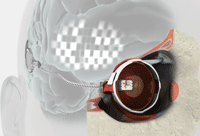Researchers in Australia made history last month after confirming the first successful “bionic eye” implant in the world.

Artist’s rendering of the bionic eye shows the electrode array implant at the back of the retina. Image: Bionic Vision Australia
Scientists at Bionic Vision Australia (BVA) surgically implanted a prototype of the bionic eye in 54-year-old Dianne Ashworth, who suffers vision loss due to retinitis pigmentosa. When the implant was first switched on and stimulated last month, Ms. Ashworth saw a flash of light and shapes in her previously blind eye.
The device, placed between the choroid and the sclera, is equipped with 24 electrodes and a small wire that extends from the back of the eye to a receptor behind the ear. When stimulated, the electrodes signal the surviving retinal cells in the eye, giving the patient the ability to “see” once again.
“The bionic eye technology relies on the patient having a healthy optic nerve and a developed visual cortex,” the researchers said. “Patients need to have been able to see in the past for this device to be of benefit to them.” They expect the bionic eyes to have the greatest benefit in people with retinitis pigmentosa and macular degeneration.
Next, the team at BVA will work with Ms. Ashworth to gather measurements and feedback, which will help them develop a visual processor and build better images using the flashes of light. Ultimately they will attach a pair of eyeglasses with a mounted digital camera to the device and refine the vision using an implant with more electrodes.
Scientists at BVA are already developing two additional devices—a 98-electrode wide-view bionic eye implant and a 1024-electrode high acuity implant. The wide-view device would allow patients who have severe vision loss to see the contrast between light and dark shapes, helping to aid mobility and enhance their independence. The high acuity version would greatly enhance central vision, allowing patients to once again recognize faces and even read large-print books.

